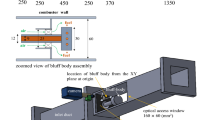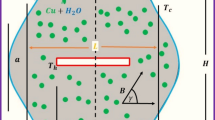Abstract
In this research study, combustion of micron-sized porous magnesium particle which freely falls into an infinite hot oxidizer medium is investigated. To examine the particle behavior during the process, acceleration and all forces acting on it including mass, buoyancy and drag forces are considered. The effects of produced magnesium oxide and both types of porosity consisting of surface and volume porosities are applied in mathematical modeling. The governing equations including magnesium particle mass continuity, linear momentum balance and energy conservation are numerically solved. Afterward, the impacts of important parameters on combustion characteristics are studied. Results show that by considering both types of surface and volume porosities, combustion time decreases compared to the cases in which one of these parameters is employed. With increasing the particle diameter and its porosity factor, velocity and acceleration enhance. Moreover, during the combustion process, mass and drag forces of magnesium oxide and its radius variations have the most effective contributions in total acceleration with the shares of 39.8%, 30.07% and 12.8%, respectively. Also, contribution of magnesium oxide in total acceleration is 4.8 times greater than that of magnesium.













Similar content being viewed by others
Abbreviations
- \(A_{\text{eff}}\) :
-
Effective surface area (m2)
- a :
-
Particle acceleration (m s−2)
- Bi:
-
Biot number
- \(C_{\text{ox}}\) :
-
Weight fraction of oxygen in air
- \(C_{\text{P}}\) :
-
Specific heat of particle (J K−1 kg−1)
- \(E_{\text{a}}\) :
-
Activation energy (J kg−1)
- \(F_{\text{B}}\) :
-
Buoyant force (kg m s−2)
- \(F_{\text{D}}\) :
-
Drag force (kg m s−2)
- \(\overline{h}_{\text{conv}}\) :
-
Average of convective heat transfer coefficient (W m−2 K−1)
- k :
-
Thermal conductivity (W m−1 K−1)
- K :
-
Permeability (m2)
- m :
-
Mass (kg)
- Mw:
-
Molecular weight (kg mol−1)
- Nu:
-
Nusselt number
- Pe:
-
Peclet number
- Pr:
-
Prandtl number
- \(Q_{\text{Comb}}\) :
-
Specific heat of magnesium combustion (J kg−1)
- r :
-
Radius (m)
- R :
-
Pore radius (m)
- \(r_{{{\text{Mg}},0}}\) :
-
Magnesium initial radius (m)
- Re:
-
Reynolds number
- \(R_{\text{Mg}}\) :
-
Gas constant for magnesium (J K−1 kg−1)
- \(r_{\text{P}}\) :
-
Particle radius (m)
- t :
-
Time (s)
- T :
-
Temperature (K)
- T :
-
Initial temperature (K)
- \(T_{\text{surr}}\) :
-
Temperature of surrounding (K)
- \(T_{\infty }\) :
-
Temperature of oxidizer medium (K)
- V :
-
Volume (m3)
- v :
-
Velocity (m s−1)
- W :
-
Mass force (kg m s−2)
- x :
-
Location (m)
- ε :
-
Emissivity
- \(\upvarepsilon_{\iota }\) :
-
Defined in Eq. 20
- μ :
-
Dynamic viscosity (m kg−1 s−1)
- ρ :
-
Density (kg m−3)
- σ :
-
Stefan–Boltzmann constant (W m−2 K−4)
- τ :
-
Magnesium burning time (ms)
- φ :
-
Porosity factor
- ω :
-
Reaction rate (kg s−1 m−2)
- in:
-
Input
- out:
-
Output
- Mg:
-
Magnesium
- MgO:
-
Magnesium oxide
- com:
-
Combustion
- sys:
-
System
- \(\infty\) :
-
Oxidizer medium
References
Guo Y, Zhang W, Zhou X, Bao T. Magnesium boride sintered as high-energy fuel. J Therm Anal Calorim. 2013;113(2):787–91.
Lăzăroaie C, Eşanu S, Său C, Petre R, Iordache P-Z, Staikos G, et al. Temperature measurements of magnesium-and aluminum-based flares. J Therm Anal Calorim. 2014;115(2):1407–15.
Liu L-l, Liu P-j, He G-q. Ignition and combustion characteristics of compound of magnesium and boron. J Therm Anal Calorim. 2015;121(3):1205–12.
Moser G, Tschamber V, Schönnenbeck C, Brillard A, Brilhac J-F. Non-isothermal oxidation and kinetic analysis of pure magnesium powder. J Therm Anal Calorim. 2019;136(5):2145–55.
Brown A, Zaky S, Ray H Jr, Sfeir C. Porous magnesium/PLGA composite scaffolds for enhanced bone regeneration following tooth extraction. Acta Biomater. 2015;11:543–53.
Čapek J, Vojtěch D. Properties of porous magnesium prepared by powder metallurgy. Mater Sci Eng C. 2013;33(1):564–9.
Jiang G, He G. A new approach to the fabrication of porous magnesium with well-controlled 3D pore structure for orthopedic applications. Mater Sci Eng C. 2014;43:317–20.
Tan L, Gong M, Zheng F, Zhang B, Yang K. Study on compression behavior of porous magnesium used as bone tissue engineering scaffolds. Biomed Mater. 2009;4(1):015016.
Dreizin EL, Hoffmann VK. Constant pressure combustion of aerosol of coarse magnesium particles in microgravity. Combust Flame. 1999;118(1–2):262–80.
Dreizin EL, Berman CH, Vicenzi EP. Condensed-phase modifications in magnesium particle combustion in air. Combust Flame. 2000;122(1–2):30–42.
King MK. A simplified two-reaction zone model of magnesium combustion in carbon dioxide. Proc Combust Inst. 2002;29(2):2931–8.
Abbud-Madrid A, Modak A, Branch MC, Daily JW. Combustion of magnesium with carbon dioxide and carbon monoxide at low gravity. J Propul Power. 2001;17(4):852–9.
Miller T, Garza A, editors. Finite rate calculations of magnesium combustion in vitiated oxygen and steam atmospheres. 4th International energy conversion engineering conference and exhibit (IECEC); 2006.
Zenin A, Kuznetsov G, Kolesnikov V. Burning of magnesium particles under zero-gravity and convective blow conditions. Russ J Phys Chem B. 2008;2(4):579–88.
Diwan M, Hanna D, Shafirovich E, Varma A. Combustion wave propagation in magnesium/water mixtures: experiments and model. Chem Eng Sci. 2010;65(1):80–7.
Zhang SM, Hu CB, Xia SY, Li L, Wei XG, editors. Ignition and combustion of magnesium particles in carbon dioxide. Applied mechanics and materials. Trans Tech Publication; 2012.
Huang X, Xia Z, Huang L, Hu J. Experimental study on the ignition and combustion characteristics of a magnesium particle in water vapor. Sci China Technol Sci. 2012;55(9):2601–8.
Bidabadi M, Yosefi SH, Poorfar AK, Hajilou M, Zadsirjan S. Modelling of combustion of a magnesium dust cloud in heterogeneous media. Combust Explos Shock Waves. 2014;50(6):658–63.
Li-Ya H, Zhi-Xun X, Wei-Hua Z, Xu H, Jian-Xin H. Combustion of a single magnesium particle in water vapor. Chin Phys B. 2015;24(9):094702.
Maghsoudi P, Bidabadi M. Modeling of combustion of moving porous magnesium particle considering variable particle size. Int J Numer Methods Heat Fluid Flow. 2019. https://doi.org/10.1108/HFF-02-2019-0163.
Feng Y-C, Xia Z-X, Huang L-Y, Ma L-K, Yang D-L. Experimental investigation on the ignition and combustion characteristics of a single magnesium particle in air. Combust Explos Shock Waves. 2019;55(2):210–9.
Zharovsky E, Moosaie A, Le Duc A, Manhart M, Simeon B. On the numerical solution of a convection–diffusion equation for particle orientation dynamics on geodesic grids. Appl Numer Math. 2012;62(10):1554–66.
Shirmohammadi R, Moosaie A. Non-Fourier heat conduction in a hollow sphere with periodic surface heat flux. Int Commun Heat Mass Transf. 2009;36(8):827–33.
Moosaie A, Shekouhi N, Nouri N, Manhart M. An algebraic closure model for the DNS of turbulent drag reduction by Brownian microfiber additives in a channel flow. J Nonnewton Fluid Mech. 2015;226:60–6.
Maghsoudi P, Shahriari G, Rasam H, Sadeghi S. Flow and natural convection heat transfer characteristics of non-Newtonian nanofluid flow bounded by two infinite vertical flat plates in presence of magnetic field and thermal radiation using Galerkin method. J Cent South Univ. 2019;26(5):1294–305.
Izadi A, Siavashi M, Xiong Q. Impingement jet hydrogen, air and CuH2O nanofluid cooling of a hot surface covered by porous media with non-uniform input jet velocity. Int J Hydrog Energy. 2019;44(30):15933–48.
Xiong Q, Kong S-C. High-resolution particle-scale simulation of biomass pyrolysis. ACS Sustain Chem Eng. 2016;4(10):5456–61.
Bozorg MV, Doranehgard MH, Hong K, Xiong Q. CFD study of heat transfer and fluid flow in a parabolic trough solar receiver with internal annular porous structure and synthetic oil–Al2O3 nanofluid. Renew Energy. 2020;145:2598–614.
Maghsoudi P, Shahriari G, Mirzaei M, Mirzaei M. Natural convection of third-grade non-Newtonian fluid flow in a porous medium with heat source: analytical solution. Eur Phys J Plus. 2018;133(12):502.
Siavashi M, Karimi K, Xiong Q, Doranehgard MH. Numerical analysis of mixed convection of two-phase non-Newtonian nanofluid flow inside a partially porous square enclosure with a rotating cylinder. J Therm Anal Calorim. 2019;137(1):267–87.
Siavashi M, Rasam H, Izadi A. Similarity solution of air and nanofluid impingement cooling of a cylindrical porous heat sink. J Therm Anal Calorim. 2019;135(2):1399–415.
Maghsoudi P, Siavashi M. Application of nanofluid and optimization of pore size arrangement of heterogeneous porous media to enhance mixed convection inside a two-sided lid-driven cavity. J Therm Anal Calorim. 2019;135(2):947–61.
Kassebaum J, Chelliah H. Oxidation of isolated porous carbon particles: comprehensive numerical model. Combust Theor Model. 2009;13(1):143–66.
Moghadasi H, Malekian N, Poorfar AK, Bidabadi M. Thermal radiative study of counterflow combustion of porous particles. Chem Eng Process Process Intensif. 2018;134:163–73.
Rasam H, Nematollahi M, Sadeghi S, Bidabadi M. An asymptotic assessment of non-premixed flames fed with porous biomass particles in counter-flow configuration considering the effects of thermal radiation and thermophoresis. Fuel. 2019;239:747–63.
Nematollahi M, Rasam H, Sadeghi S, Bidabadi M. Asymptotic prediction of multi-region planar non-premixed combustion of moisty porous coal particles in counter-flow design considering pyrolysis, homogeneous and heterogeneous reactions. Combust Flame. 2019;207:281–94.
Abbud-Madrid A, Stroud C, Omaly P, Branch M, editors. Combustion of bulk magnesium in carbon dioxide under reduced-gravity conditions. 37th Aerospace sciences meeting and exhibit; 1999.
Xie Z-K, Tane M, Hyun S-K, Okuda Y, Nakajima H. Vibration–damping capacity of lotus-type porous magnesium. Mater Sci Eng A. 2006;417(1–2):129–33.
Fedorov A. Numerical and analytical study of magnesium particle ignition. Combust Explos Shock Waves. 1996;32(1):64–72.
Zhu M, Chen X, Zhou C-S, editors. Numerical investigations on the combustion characteristics of single magnesium particle in the forced-convective flow. 23rd AIAA computational fluid dynamics conference; 2017.
Liu P. A new method for calculating the specific surface area of porous metal foams. Philos Mag Lett. 2010;90(6):447–53.
Avdeev K, Frolov F, Borisov A, Frolov S. A modified model of the ignition of a magnesium particle. Russ J Phys Chem B. 2008;2(3):456–62.
Kaviany M. Principles of heat transfer in porous media. Berlin: Springer; 2012.
Helte A. Radiative and conductive heat transfer in porous media: estimation of the effective thermal conductivity. J Appl Phys. 1993;73(11):7167–73.
Shampine LF, Reichelt MW. The matlab ode suite. SIAM J Sci Comput. 1997;18(1):1–22.
Bergman TL, Incropera FP, Lavine AS, DeWitt DP. Introduction to heat transfer. Hoboken: Wiley; 2011.
Valov A, Kustov YA, Shevtsov V. Spectroscopic study of the combustion of solitary magnesium particles in air and in carbon dioxide. Combust Explos Shock Waves. 1994;30(4):431–6.
Author information
Authors and Affiliations
Corresponding author
Additional information
Publisher's Note
Springer Nature remains neutral with regard to jurisdictional claims in published maps and institutional affiliations.
Rights and permissions
About this article
Cite this article
Maghsoudi, P., Bidabadi, M. Evaluation of dynamic behavior of a falling porous magnesium particle over the ignition and combustion processes. J Therm Anal Calorim 141, 1605–1617 (2020). https://doi.org/10.1007/s10973-020-09759-9
Received:
Accepted:
Published:
Issue Date:
DOI: https://doi.org/10.1007/s10973-020-09759-9




